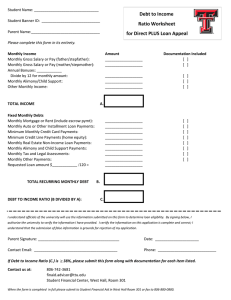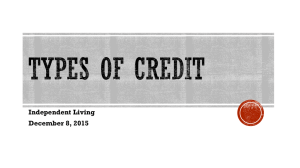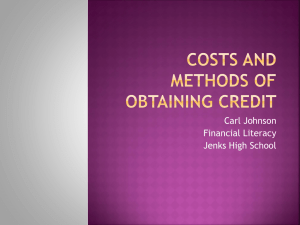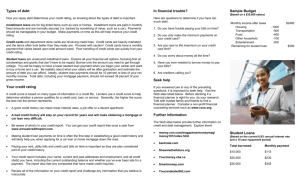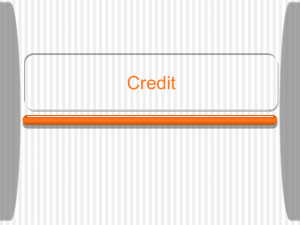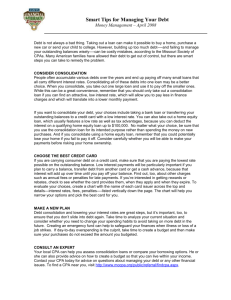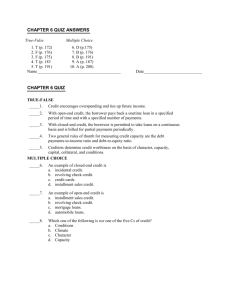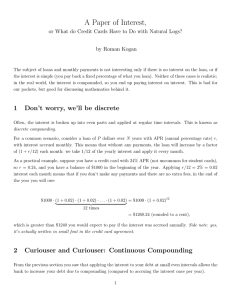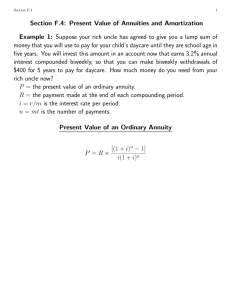Credit Management: Scores, Cards, and Challenges
advertisement
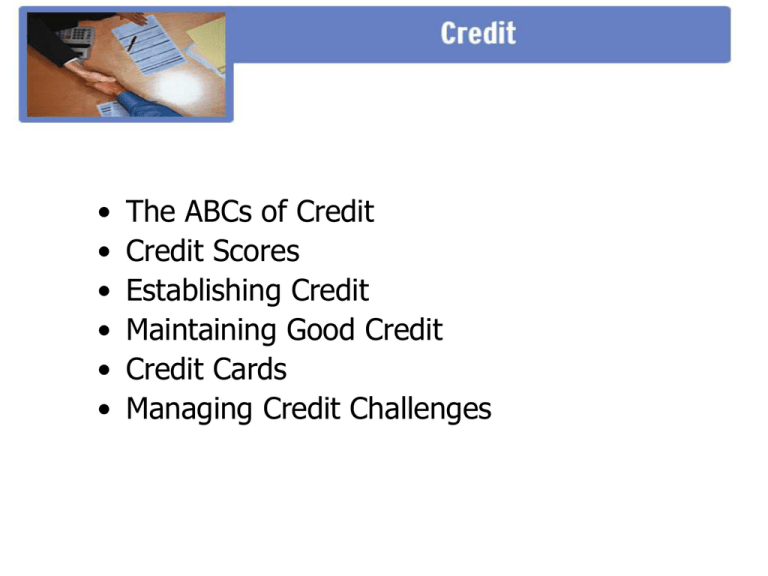
• • • • • • The ABCs of Credit Credit Scores Establishing Credit Maintaining Good Credit Credit Cards Managing Credit Challenges CREDIT DEFINITIONS Credit Trust given to another person for future payment of a loan, credit card balance, etc. Creditor A person or company to whom a debt is owed. 2 THE FIVE Cs OF CREDIT C = Capacity C = Capital C = Collateral C = Conditions C = Character 3 WHEN TO USE CREDIT Can you describe a situation when it is a good time to use credit and when it is NOT a good time to use credit? 4 QUESTIONS TO ASK BEFORE USING CREDIT 1. 2. 3. 4. 5. 6. 7. 5 WHAT IS A CREDIT SCORE? 6 • A credit score is a number that helps a lender predict how likely an individual is to repay a loan, or make credit payments on time. • A credit score is a number that changes as the elements in a credit report change. • A credit score has broad use and impact. Your credit past is your credit future. • FICO® scores, one of the most common credit scoring systems, vary between 350 and 850. • VantageScoreSM, a new credit scoring system developed by the three credit bureaus, ranges from 501-990. WHAT MAKES UP A TYPICAL CREDIT SCORE? Source: Fair Isaac and Consumer Federation of America, 2005 7 IMPROVING YOUR CREDIT SCORE 8 • Pay bills on time. • Get current and stay current. • Don’t open a lot of new accounts too rapidly. • Correct mistakes. • Shop for loan rates within a focused period of time. • Keep balances low on revolving credit. • • Pay off debt. Check your credit report. TYPES OF CREDIT 9 Cash Credit I.O.U. Sales Credit Single Payment Credit Secured Credit Installment Credit Revolving Credit Other Types of Credit SOURCES OF CREDIT Banks Retail Stores Savings & Loan Associations Credit Unions Finance Companies Internet Stores What are other sources of credit? What sources of credit should be avoided? Why? 10 STEPS TO TAKE TO AVOID ABUSIVE LENDING 1. Have you shopped around for the best deal? 2. Do you feel the lender pressured you to take the loan? 3. Do you understand the terms of the loan? 11 COMMON PARTS OF A CREDIT APPLICATION • • • • • • • • • • 12 Reason for Loan Personal Identification Information Employment Information Mortgage/Rental Information Documentation Required (for some applications) Current Debts Credit References Collateral (for some applications) Bank References Signature and Date SAMPLE CREDIT APPLICATION 13 QUESTIONS TO ASK WHEN APPLYING FOR CREDIT 1. 2. 3. What is the annual fee? What is the annual percentage rate (APR)? When are payments due? 4. 5. 6. What is the minimum payment required each month? Is there a grace period? Are there other fees associated with the credit, such as minimum finance charges? What is the credit limit? 7. 8. 9. 14 What are the penalties for late or missed payments? What are the terms and conditions of the credit? What else is included in the fine print? Maintaining Good Credit Overview • Debt to income thermometer • Credit process • Credit reporting agencies • Credit safeguards for consumers • Credit reports, ratings and scores • Establishing a credit history 15 DEBT-TO-INCOME THERMOMETER 16 THE CREDIT PROCESS CREDIT HISTORY • CREDIT BUREAU • CREDIT REPORT • CREDIT SCORE • CREDIT RATING 17 SAMPLE CREDIT REPORT 18 CREDIT SAFEGUARDS FOR CONSUMERS Truth In Lending Act Fair Credit Reporting Act Equal Credit Opportunity Act Fair Credit Billing Act Fair Debt Collection Practices Act 19 THE FAIR AND ACCURATE CREDIT TRANSACTION ACT One of the primary objectives behind the Fair and Accurate Credit Transaction Act (the FACT Act) is to help consumers fight the growing crime of identity theft. The following are some highlights of the Act. • Free credit reports • Fraud alerts and Active Duty alerts • Truncation: credit cards, debit cards, Social Security Number • Red flags • Disposal of consumer reports • Credit scores 20 THINGS TO DO TO ESTABLISH AND MAINTAIN GOOD CREDIT What can everyone do to establish and maintain good credit? 1. Pay all bills on time. 2. Avoid late fees. 3. 4. 5. 6. 21 Credit Cards Overview • Types of credit cards • Shopping for a credit card • Costs of credit 22 TYPES OF CREDIT CARDS Private Label • Issued by a single source • Can only be used at a single source • Examples: Department Stores, Gasoline Companies General Label • Issued by a single source • Can be used in many places • Examples: Bank Card, Major Credit Card 23 SHOPPING FOR A CREDIT CARD DECISIONS, DECISIONS... ANNUAL FEE? APR? COMPUTATION METHOD? GRACE PERIOD? FINANCE CHARGE? CREDIT LIMIT? CARD INCENTIVES? 24 QUESTIONS TO ASK WHEN SHOPPING FOR A CREDIT CARD 25 • Annual fee • • • • • • Annual percentage rate (APR) Minimum payment Computation method Grace period Finance charges Card incentives COSTS OF CREDIT How much can credit cost? If you make only the minimum payment for an item, here are some examples of what you might actually pay and how long it will take you to pay it. 26 Managing Credit Challenges Overview • • • • 27 Warning signs of credit abuse Credit card reductions Correcting credit errors Resources and assistance MEASURING THE SERIOUSNESS OF CREDIT TROUBLE SIGNS Rate how serious you think each of the following trouble signs is. 1 = Not Serious 4 = Very Serious Trouble Signs • • • • 28 Delinquent Payments Default Notices Repossessions Collection Agencies • Lien • Garnishment • Others? WARNING SIGNS OF DEBT PROBLEMS 1. Delinquent Payments 2. Default Notices 3. 4. 5. 6. 29 Repossessions Collection Agencies Judgment Lien Garnishment CREDIT CARD REDUCTIONS Paying only the minimum payments on your credit card may seem appealing, but if only minimum payments are made, it can take years, and sometimes decades, to achieve full repayment. Paying the minimum amount due keeps your credit history clean, but it also costs you more. 30 CORRECTING CREDIT ERRORS 1. Circle the incorrect items on your credit report. 2. Write a letter to the reporting agency, telling them which information you think is inaccurate. Provide supporting documentation. 3. Send all materials by certified mail. 4. Send a similar letter to the creditor whose reports you disagree with. 5. The reporting agency will conduct an investigation. 6. If negative information is accurate, it can stay on your report for 7-10 years. 31 CORRECTING CREDIT PROBLEMS 32 • • Take responsibility for actions. Communicate with creditors. • • • Debt Consolidation Credit Counseling Bankruptcy
